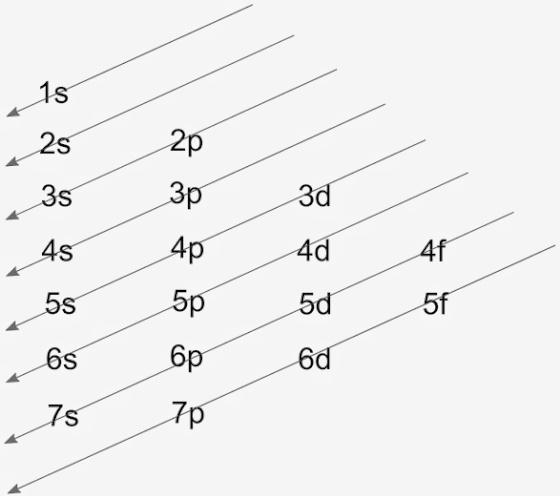
What is the electron configuration for cobalt z = 27? Why?
Answer
420.9k+ views
Hint: The electronic configuration of any element tells us the total number of electrons present in that atom. It is identified through atomic number, as the atomic number of an atom tells us the total number of electrons in that atom. The electronic configuration requires filling of orbital or sub shells (s, p, d, f) according to Aufbau principle.
Complete answer:
The Electronic configuration of any atom tells us the total number of electrons which is equal to the total number protons in that atom that is equal to the atomic number of that element. Electronic configuration of any element consists of filling the orbital or the s, p, d, f sub – shells with electrons. The filling of electrons in various orbits is according to a principle of Aufbau that takes place from the lower energy level to the higher energy level. The s, p, d, f subshells are written along with the number of the shell, like 1,2, 3, etc.
We have been given cobalt which has atomic number z = 27. The electronic configuration of cobalt will consist of filling 27 electrons according to the Aufbau principle. The Aufbau diagram that shows filling is,

The arrows denote the manner of filling. So, through this diagram the configuration of cobalt is, $1{{s}^{2}}2{{s}^{2}}2{{p}^{6}}3{{s}^{2}}3{{p}^{6}}4{{s}^{2}}3{{d}^{7}}$
Hence, the electronic configuration of cobalt is $1{{s}^{2}}2{{s}^{2}}2{{p}^{6}}3{{s}^{2}}3{{p}^{6}}4{{s}^{2}}3{{d}^{7}}$that has the energy levels and subshells occupied by the electrons according to the Aufbau principle.
Note:
Another type of configuration called as shorthand or noble gas configuration is used to write the configuration of elements that ease them in representing the atoms. The shorthand configuration of cobalt is $[Ar]4{{s}^{2}}3{{d}^{7}}$, where argon is noble gas with z = 18. Cobalt is the element of the d block, so the valence shell in this atom enters into the d – orbital.
Complete answer:
The Electronic configuration of any atom tells us the total number of electrons which is equal to the total number protons in that atom that is equal to the atomic number of that element. Electronic configuration of any element consists of filling the orbital or the s, p, d, f sub – shells with electrons. The filling of electrons in various orbits is according to a principle of Aufbau that takes place from the lower energy level to the higher energy level. The s, p, d, f subshells are written along with the number of the shell, like 1,2, 3, etc.
We have been given cobalt which has atomic number z = 27. The electronic configuration of cobalt will consist of filling 27 electrons according to the Aufbau principle. The Aufbau diagram that shows filling is,

The arrows denote the manner of filling. So, through this diagram the configuration of cobalt is, $1{{s}^{2}}2{{s}^{2}}2{{p}^{6}}3{{s}^{2}}3{{p}^{6}}4{{s}^{2}}3{{d}^{7}}$
Hence, the electronic configuration of cobalt is $1{{s}^{2}}2{{s}^{2}}2{{p}^{6}}3{{s}^{2}}3{{p}^{6}}4{{s}^{2}}3{{d}^{7}}$that has the energy levels and subshells occupied by the electrons according to the Aufbau principle.
Note:
Another type of configuration called as shorthand or noble gas configuration is used to write the configuration of elements that ease them in representing the atoms. The shorthand configuration of cobalt is $[Ar]4{{s}^{2}}3{{d}^{7}}$, where argon is noble gas with z = 18. Cobalt is the element of the d block, so the valence shell in this atom enters into the d – orbital.
Recently Updated Pages
How do you factor x2 + x 20 0 class 9 maths CBSE

How do you solve y6x and 2x+3y20 using substitutio class 9 maths CBSE

Chipko movement originated in Gopeshwar in A 1953 B class 9 biology CBSE

The adjacent sides in the parallelogram are supplementary class 9 maths CBSE

The compound used in plastic industry is A Vinyl acetate class 9 chemistry CBSE

How do you solve for y in 2left y dfrac12 right 4left class 9 maths CBSE

Trending doubts
Write the difference between soap and detergent class 10 chemistry CBSE

When was Shivaji born A 1632 B 1627 C 1678 D 1634 class 10 social science CBSE

a Why did Mendel choose pea plants for his experiments class 10 biology CBSE

State and explain Ohms law class 10 physics CBSE

The Equation xxx + 2 is Satisfied when x is Equal to Class 10 Maths

Differentiate between Food chain and Food web class 10 biology CBSE




